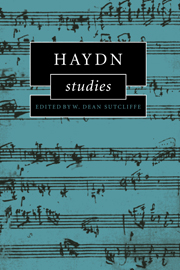Book contents
- Frontmatter
- Contents
- Preface
- Editor's note
- 1 The consequences of presumed innocence: the nineteenth-century reception of Joseph Haydn
- 2 Haydn's sacred vocal music and the aesthetics of salvation
- 3 Sentiment and sensibility in La vera costanza
- 4 Haydn as Romantic: a chemical experiment with instrumental music
- 5 Haydn's ‘Cours complet de la composition’ and the Sturm und Drang
- 6 Haydn's reversals: style change, gesture and the implication-realization model
- 7 Haydn's symphonies between Sturm und Drang and ‘Classical style’: art and entertainment
- 8 The Haydn piano trio: textual facts and textural principles
- 9 Papa Doc's recap caper: Haydn and temporal dyslexia
- 10 Haydn: the musicians' musician
- Index
Preface
Published online by Cambridge University Press: 22 September 2009
- Frontmatter
- Contents
- Preface
- Editor's note
- 1 The consequences of presumed innocence: the nineteenth-century reception of Joseph Haydn
- 2 Haydn's sacred vocal music and the aesthetics of salvation
- 3 Sentiment and sensibility in La vera costanza
- 4 Haydn as Romantic: a chemical experiment with instrumental music
- 5 Haydn's ‘Cours complet de la composition’ and the Sturm und Drang
- 6 Haydn's reversals: style change, gesture and the implication-realization model
- 7 Haydn's symphonies between Sturm und Drang and ‘Classical style’: art and entertainment
- 8 The Haydn piano trio: textual facts and textural principles
- 9 Papa Doc's recap caper: Haydn and temporal dyslexia
- 10 Haydn: the musicians' musician
- Index
Summary
The advances in Haydn scholarship that have been made in the past forty years or so would have been unthinkable to earlier generations, who honoured the composer rather more in word than in deed. The composer has once more become what he became in his lifetime, a big player on the musical stage – especially in the last ten to twenty years – and the industry surrounding his works shows no signs of a slump. Because of the late start suffered by Haydn in musicological terms, a sense of evangelizing zeal still surrounds much of the scholarly and performing activity on his behalf, informed by a confidence that the composer is ‘on the up’. However, for all the advances made in our knowledge of Haydn, the balance of this progress has been rather uneven. Not surprisingly, most attention has been devoted to all the musicological problems surrounding such a vast and widely dispersed creative output – matters of authenticity, chronology, documentation, performance practice, and the establishment of reliable and scholarly editions. On the other hand, in hermeneutic terms, the Haydn industry is still young, perhaps in obedience to the old unwritten law of musical research that demanded a full tally of ‘facts’ before proper aesthetic interpretation could begin. This may be somewhat unfair, since work that answers this need has begun to appear in more than isolation, but there is no doubt that the general thrust of Haydn research has been highly positivistic.
- Type
- Chapter
- Information
- Haydn Studies , pp. vii - xiiPublisher: Cambridge University PressPrint publication year: 1998

